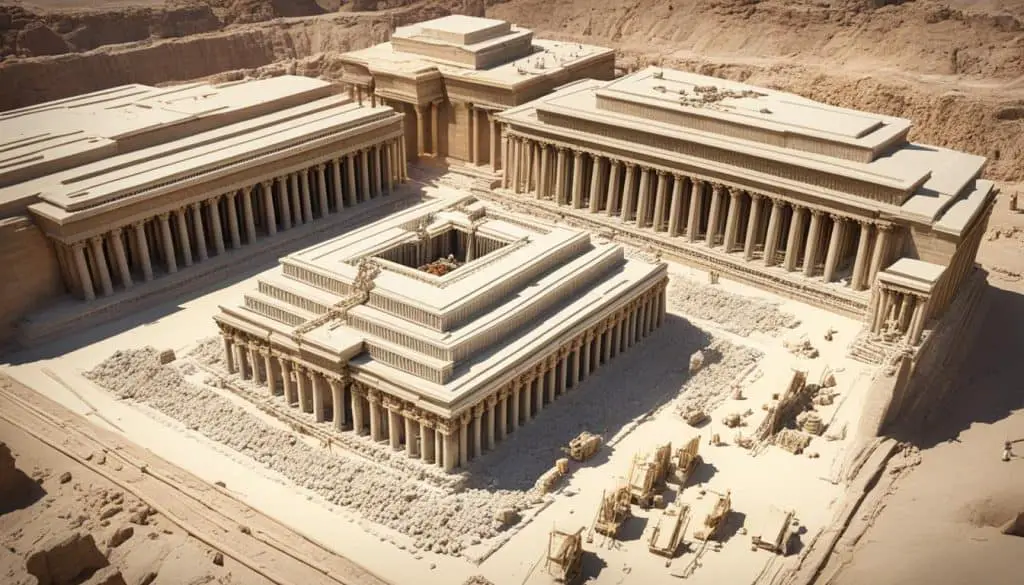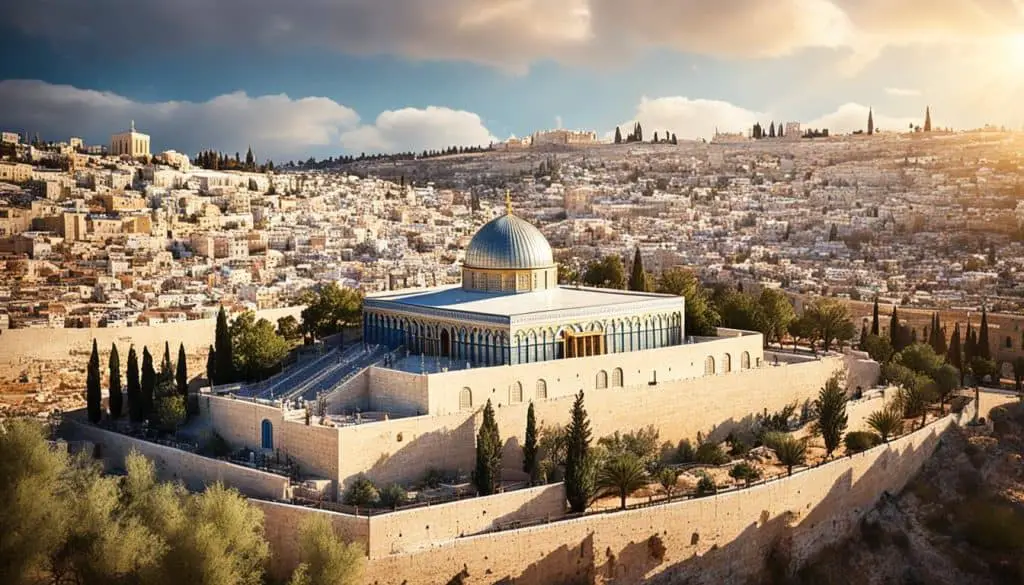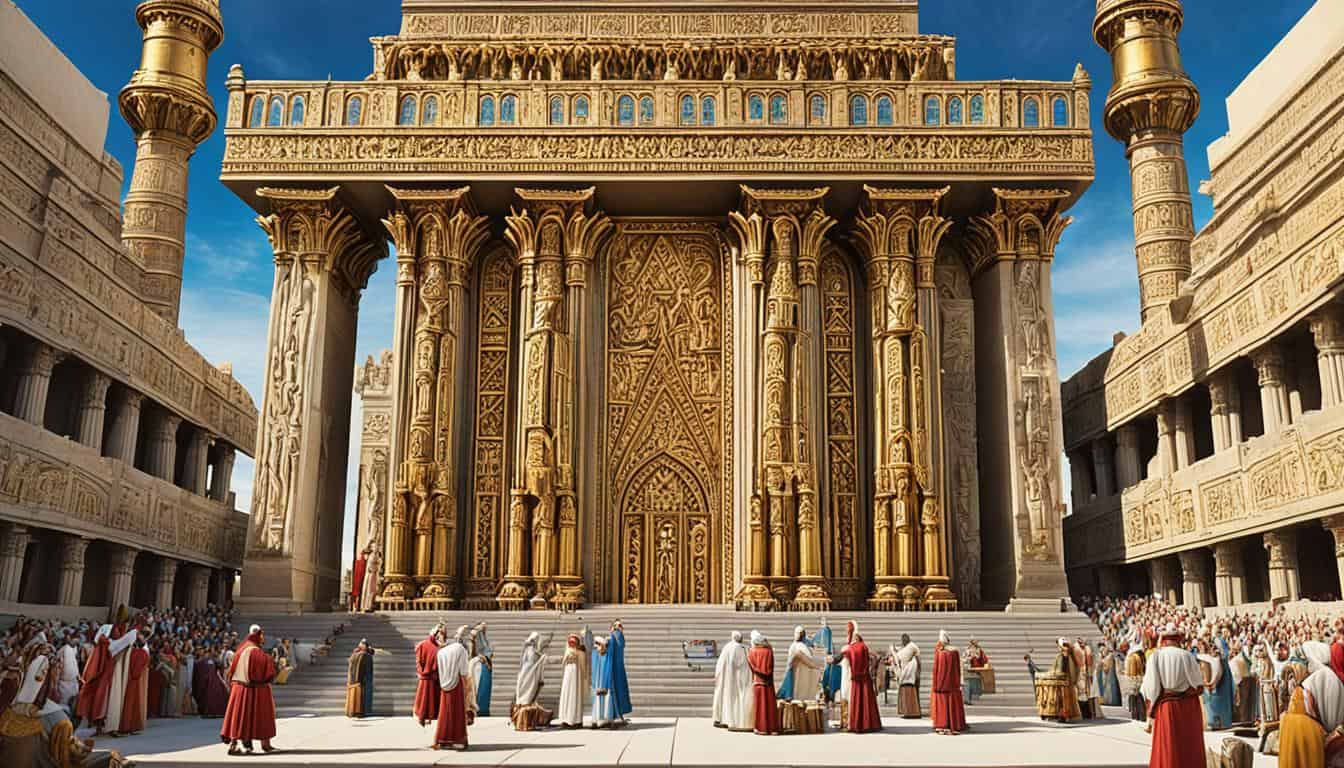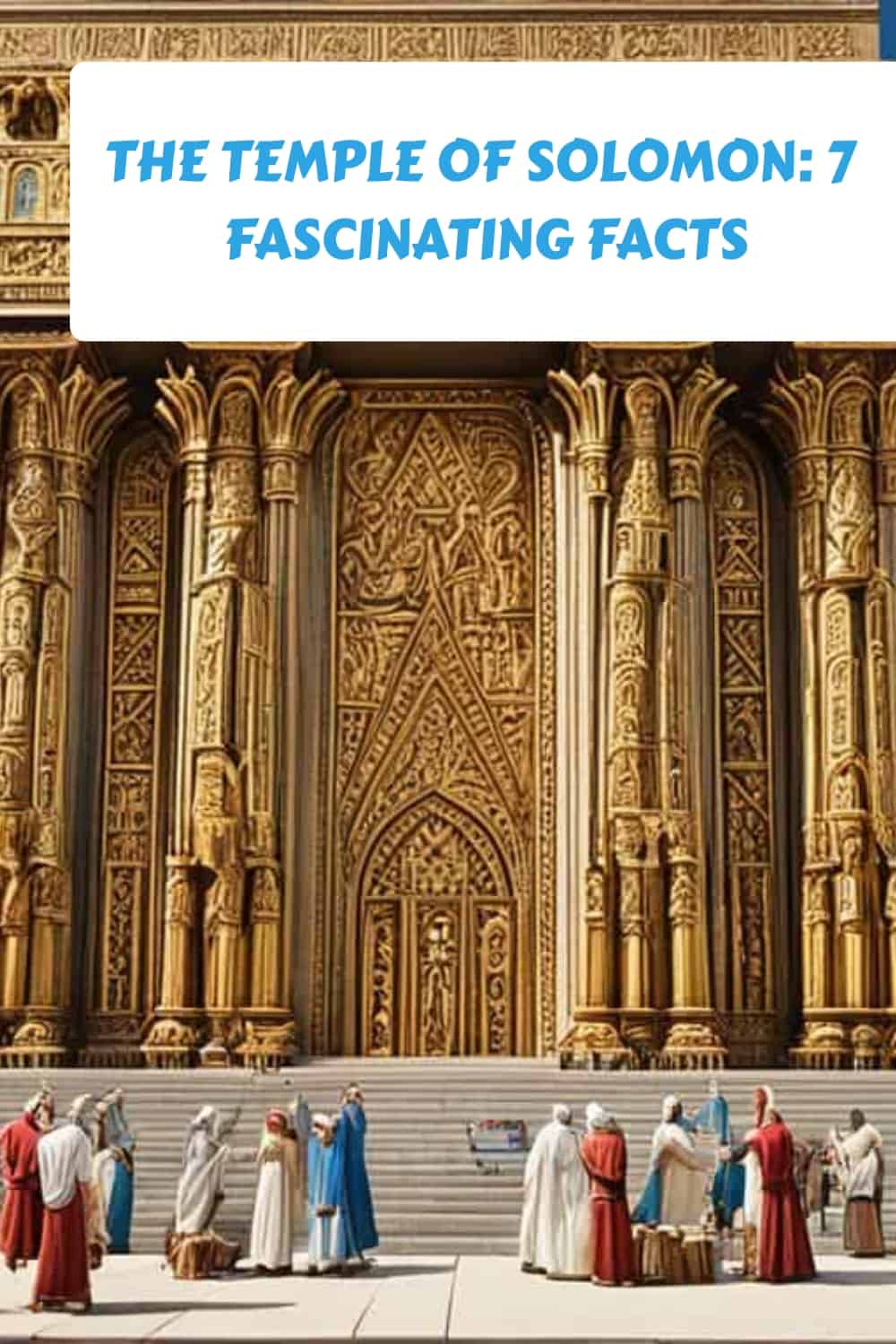Table of Contents
Have you ever wondered about the secrets and mysteries surrounding the Temple of Solomon? How was this magnificent structure built according to a divine blueprint? What was the king’s promise that drove its creation? And just how much gold adorned its walls? Prepare to be captivated as we delve into the intriguing history of the Temple of Solomon, a construction feat that remains lost to time.
Join us on a journey of discovery as we explore the significance of its location, the symbol of unity it became for the Israelites, and the ultimate fate of this ancient marvel. From its awe-inspiring architecture to its rich history, the Temple of Solomon is sure to leave you amazed.
A Divine Blueprint: An Architectural Marvel
When it comes to awe-inspiring architectural designs, few structures in history can compare to the magnificence of the Temple of Solomon. This sacred edifice was more than just an impressive building; it was believed to be a divine blueprint, a marvel crafted under the guidance of a higher power.
The architects and craftsmen behind the Temple of Solomon must have felt like they were receiving dream house plans straight from a cloud. The intricate details and precision of its construction make it one of the greatest architectural achievements of its time. Every aspect of the temple, from its intricate carvings to its grand pillars, showcased the pinnacle of craftsmanship and devotion.
The Divine Inspiration
According to biblical accounts, King Solomon received instructions for the temple’s design from God Himself. The meticulous plans outlined every architectural element and feature, ensuring that the temple was a true embodiment of divine inspiration.
“And David gave Solomon his son the pattern of the porch, and of the houses thereof, and of the treasuries thereof, and of the upper chambers thereof, and of the inner parlours thereof, and of the place of the mercy seat,” (1 Chronicles 28:11-12).
These instructions were meticulously followed to bring to life a structure that would stand as a testament to the union between heaven and earth.
An Architectural Marvel
The Temple of Solomon boasted elaborate details and intricate designs that left visitors in awe. From the intricately carved walls to the majestic pillars, every inch of this architectural marvel reflected the divine blueprint it was based upon.
Below is a table highlighting some of the main architectural features of the Temple of Solomon:
| Architectural Feature | Description |
|---|---|
| 1. Grand Pillars | The temple featured two towering bronze pillars, named Jachin and Boaz, which symbolized strength and stability. |
| 2. Lavish Decorations | Gold adorned the walls, doors, and furnishings, reflecting the opulence and grandeur of the divine presence. |
| 3. Inner Sanctuaries | The Holy Place and the Holy of Holies were sacred chambers within the temple where the divine presence was believed to dwell. |
| 4. Ornate Carvings | Stone carvings adorned the temple walls, depicting intricate motifs of flora, fauna, and religious symbolism. |
This architectural masterpiece, designed according to the divine blueprint, not only served as a place of worship but also stood as a symbol of faith and unity for the Israelites.
A King’s Promise Kept: Solomon’s Legacy
Upon learning about King David’s desire to build a grand temple, his son, Solomon, took on the monumental task of fulfilling this ambitious dream. The temple project was not just about constructing a impressive structure; it was about honoring his father’s legacy and creating a lasting symbol of devotion to God.
In this section, we will explore the story behind the Temple of Solomon and the family goals that drove Solomon’s determination to make his father’s vision a reality. Let’s delve into the details of how Solomon upheld his father’s promise and left a remarkable legacy for future generations to marvel at.
“I intend to build a temple for the name of the Lord my God, as the Lord said to my father, David, ‘Your son, whom I will set on your throne in your place, shall build the temple for my name.'” – Solomon
Driven by his love for his father and his desire to honor God, Solomon embarked on a journey of architectural brilliance. He envisioned a temple that would surpass anything the world had seen before, a structure that would reflect the glory and power of God.
To fully comprehend the magnitude of the king’s promise, let’s explore some key aspects of Solomon’s legacy:
The Promise Made
The Temple of Solomon was not just an architectural feat but an expression of a promise made by King David. David, Solomon’s father, had longed to build a magnificent temple for God but was forbidden to do so because of his bloodshed. Instead, he received divine assurance that his son would undertake the task.
A Testimony of Devotion
Solomon’s commitment to fulfilling his father’s promise was a testament to his deep devotion to God. He dedicated countless resources and the skills of talented craftsmen to ensure the temple’s splendor, sparing no expense in honoring his father’s commitment.
A Gathering Place for Worship
The completion of the Temple of Solomon provided a central place for the Israelites to come together and worship. It became a sacred space, a symbol of unity and faith, where people could offer sacrifices and seek divine guidance. The temple served as a spiritual anchor, solidifying the bond between God and the people.
By fulfilling his father’s promise, Solomon left an indelible legacy, showcasing not only his ability to lead and govern but also his devotion to the divine. The Temple of Solomon was a testament to the power of a king’s promise, a physical embodiment of faith and commitment to God.

Solomon’s Legacy in Numbers
| Years of Construction | Labor Force | Materials |
|---|---|---|
| 7 | Over 150,000 skilled workers | Tons of gold, silver, and bronze |
Gold, Gold, and More Gold: The Ultimate Ancient Bling
Step into the opulence of the Temple of Solomon, adorned with a dazzling display of gold. This majestic structure was a true treasure chest, brimming with the precious metal in every corner, a sight that would make even the most discerning lover of bling-bling weak at the knees.
Imagine walking through halls encased in gold-laden walls, reflecting a mesmerizing glow that echoed the divine presence within. The artisans of ancient times spared no expense, crafting intricate designs that showcased the unrivaled beauty of this precious metal.
“The Temple of Solomon shone like a beacon, its lavish display of gold captivating every eye that beheld it. It was a testament to the wealth and power of King Solomon, a symbol of his devotion to the divine.”
Enticing not only to the eyes, but also to the touch, the temple’s gold utensils were nothing short of spectacular. From intricate chalices to elaborate candelabras, each piece exuded unparalleled craftsmanship and elegance. Even the smallest of details were not overlooked, as they were expertly fashioned from the most precious of metals.
As a testament to the grandeur of the Temple of Solomon, an awe-inspiring representation of the wealth and splendor of ancient times, its gold-laden magnificence outshone any jewelry collection of today.
The Temple of Solomon: A Gold-Laden Spectacle
| Gold Decorations | Luxurious Utensils |
|---|---|
| Panels adorned with gold leaf | Elaborate chalices |
| Intricate gold carvings | Exquisite candelabras |
| Gold plating on walls | Radiant golden altar |
A Construction Feat: Ancient DIY on a Grand Scale
Embark on a journey back in time as we delve into the awe-inspiring construction process of the Temple of Solomon. This monumental undertaking spanned a remarkable seven years, showcasing the incredible dedication and skill of thousands of workers. It truly was an ancient DIY project on a grand scale.
The construction of the Temple of Solomon stands as a testament to the ingenuity and craftsmanship of its time. Ancient builders employed innovative techniques to create a structure that has mesmerized generations with its architectural brilliance.
“The construction of the Temple of Solomon was an extraordinary feat of human engineering, demonstrating the ancient world’s advanced understanding of construction principles.”
The construction site buzzed with activity as workers meticulously laid the foundation, erected mighty walls, and carved intricate details. Stone by stone, the grandeur of the temple took shape, capturing the attention and admiration of all who witnessed its rise.
Thousands of Skilled Workers Unite
Building the Temple of Solomon required the collaborative efforts of a vast workforce. Skilled artisans, stonemasons, carpenters, and laborers worked in unison, each contributing their unique expertise to bring the divine blueprint to life.
The project wasn’t just about construction; it was a symphony of craftsmanship and labor. Every worker played a crucial role in the meticulous execution of their designated task, ensuring precision and excellence in every aspect of the temple’s construction.
“The Temple of Solomon is a testament to the human capacity for ingenuity, teamwork, and dedication. It stands as a symbol of the ancient world’s ability to come together and achieve extraordinary feats of construction.”
Imagine the hustle and bustle of the construction site—the clinking of hammers, the chiseling of stones, the sawing of timbers. The symphony of construction echoed throughout the land as this remarkable structure took form, serving as a testament to human ambition and determination.

Through their collective efforts, the workers transformed raw materials into a masterpiece that would inspire awe for centuries to come. Their dedication and perseverance turned an ambitious vision into a tangible symbol of divinity and human achievement.
“The construction of the Temple of Solomon exemplifies the boundless heights that can be reached when human creativity, dedication, and skill unite in the pursuit of a common goal.”
Join us as we continue to unravel the extraordinary stories and mysteries surrounding this ancient wonder. In the next section, we will explore the significant location of the Temple of Solomon and its spiritual significance in the hearts and minds of those who revered it.
Not Just Any Location: A Site of Spiritual Significance
Unearth the historical and spiritual significance of the Temple of Solomon’s location on Mount Moriah in Jerusalem. This sacred site holds a deep-rooted connection to the spiritual identity of the region, making it more than just any ordinary location.
Mount Moriah, located in Jerusalem, has been a place of divine encounters and religious importance for centuries. Its spiritual significance can be traced back to biblical times and is intertwined with the stories and traditions of different faiths.
According to Judeo-Christian tradition, Mount Moriah is believed to be the very place where Abraham was tested by God, as depicted in the story of the sacrifice of his son, Isaac. This poignant tale highlights the obedience and faith of Abraham and symbolizes the divine-human relationship.
“And he said, ‘Do not lay your hand on the boy or do anything to him, for now I know that you fear God, seeing you have not withheld your son, your only son, from me.'” – Genesis 22:12
This powerful story has left an indelible mark on Mount Moriah and has solidified its status as a site of spiritual significance and sacrifice.
For the Jewish faith, Mount Moriah holds even greater importance as it is believed to be the location of both the First and Second Temples. The Temple of Solomon was constructed on this hallowed ground, serving as the central religious and cultural hub of the Jewish people.
Additionally, Mount Moriah holds significance for Muslims, who believe it to be the location of the Al-Aqsa Mosque and the Dome of the Rock. As the third holiest site in Islam, it is revered as the place from which the Prophet Muhammad ascended to heaven during the Night Journey.
The collective spiritual and historical weight carried by Mount Moriah and its association with the Temple of Solomon contributes to its enduring allure. It serves as a powerful reminder of the faith, devotion, and connections that shape our lives and shape the world around us.

The Significance of Mount Moriah in Different Faiths:
- In Judaism, Mount Moriah is the site of the First and Second Temples, a symbol of the Jewish people’s spiritual and cultural heritage.
- For Christians, the sacrifice of Abraham’s son on Mount Moriah foreshadows the ultimate sacrifice of Jesus Christ.
- In Islam, Mount Moriah is believed to be the location of the Al-Aqsa Mosque and the Dome of the Rock, representing the importance of this site in Muslim religious history.
A Symbol of Unity and Faith
When you think of the Temple of Solomon, you may envision a magnificent structure with stunning architectural details and lavish decorations. However, this ancient temple was more than just a physical marvel. It held great significance as a symbol of unity and faith for the Israelites.
The Temple of Solomon brought people together from all corners of the kingdom, transcending differences and fostering a sense of unity among the Israelites. Regardless of their social status or tribal affiliations, worshipers gathered within its sacred walls, bound by their shared beliefs.
As a religious and spiritual center, the Temple of Solomon played a central role in the Israelite community. It served as a focal point for religious rituals, gatherings, and celebrations, allowing individuals to connect with their faith and with one another.
“The temple was a place where we could come together, leaving our differences behind,” says Rachael Cohen, a biblical historian. “It was here that the Israelites reaffirmed their commitment to their religion and their shared identity as a nation.”
“The Temple of Solomon became a physical embodiment of the Israelites’ collective faith,” says Professor David Silverman, an expert in ancient Near Eastern studies. “It served as a reminder that despite their various backgrounds, they were united in their devotion to their God and their people.”
Beyond its religious significance, the Temple of Solomon also symbolized the Israelites’ unity as a people. It stood as a testament to their ability to come together, overcome challenges, and create something extraordinary. The construction of this grand edifice required the cooperation of thousands of skilled workers, demonstrating the power of collective effort.
Whether it was during times of celebration, repentance, or seeking divine guidance, the Temple of Solomon provided a sacred space where the Israelites could find solace and strength in their shared beliefs. It strengthened the bonds between individuals and their community, forging a deep sense of unity that extended far beyond the temple’s walls.
Through generations of storytelling and study, the Temple of Solomon continues to inspire reverence and awe. Its legacy as a symbol of unity and faith endures, reminding us of the power of coming together and the strength found in shared values.

| Symbol of Unity | Description |
|---|---|
| Shared Beliefs | The Temple of Solomon brought together the Israelites, regardless of their social status or tribal affiliations, fostering a sense of unity based on their shared beliefs. |
| Collective Effort | The construction of the temple required the cooperation of thousands of workers, demonstrating the power of collective effort and the potential when people unite towards a common goal. |
| Community Bonding | The temple served as a center for religious rituals and gatherings, providing a space where individuals could connect with their faith and strengthen their sense of community. |
What are the similarities and differences between the Temple of Solomon and the Second Temple?
The key events and changes at the Temple of Solomon and the Second Temple marked significant points in history. Both temples were central to Jewish worship. However, the Second Temple differed architecturally and underwent major renovations. Despite these differences, both temples were pivotal in shaping Jewish religious practices.
Lost to Time: An Ancient Mystery
As we delve into the fascinating history of the Temple of Solomon, we come face-to-face with an ancient mystery that still captivates scholars and historians today. The original temple, once a symbol of grandeur and religious significance, has been lost to time, leaving behind a trail of questions and speculation.
The destruction of the Temple of Solomon marked the beginning of a series of reconstructions and renovations throughout history. While some remnants and artifacts have been excavated, the full extent of the temple’s glory and intricate details remain elusive, shrouded in the enigmatic veil of time.
Researchers and archeologists continue to explore the depths of this ancient mystery, piecing together fragments of historical accounts, ancient texts, and archaeological finds. Although the Temple of Solomon may no longer exist in its original form, through the immeasurable efforts of these dedicated individuals, the spirit and significance of this remarkable structure live on in the annals of history.






